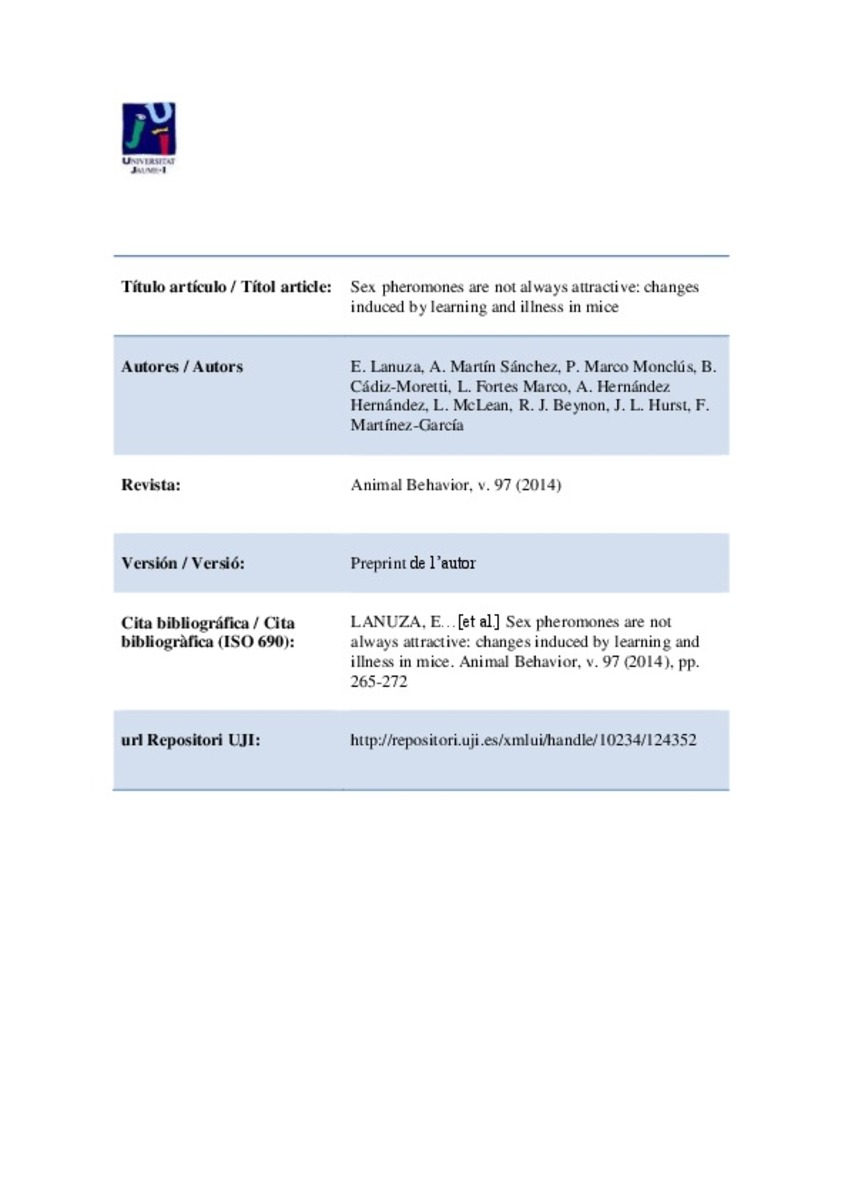Mostrar el registro sencillo del ítem
Sex pheromones are not always attractive: changes induced by learning and illness in mice
| dc.contributor.author | Lanuza, Enrique | |
| dc.contributor.author | Martín Sánchez, Ana | |
| dc.contributor.author | Marco Monclús, Pau | |
| dc.contributor.author | Cádiz-Moretti, Bernardita | |
| dc.contributor.author | Fortes Marco, Lluís | |
| dc.contributor.author | Hernández Martínez, Adoración | |
| dc.contributor.author | McLean, Lynn | |
| dc.contributor.author | Beynon, Robert J. | |
| dc.contributor.author | Hurst, Jane L. | |
| dc.contributor.author | Martinez-Garcia, Fernando | |
| dc.date.accessioned | 2015-06-19T09:58:18Z | |
| dc.date.available | 2015-06-19T09:58:18Z | |
| dc.date.issued | 2014-11 | |
| dc.identifier.citation | LANUZA, E.; MARTÍN SÁNCHEZ, A.; MARCO MONCLÚS, P.; CÁDIZ-MORETTI, B.; FORTES MARCO, L.; HERNÁNDEZ MARTÍNEZ, A.; McLEAN, L.; BEYNON, R. J.; HURST, J. L..; MARTÍNEZ-GARCÍA, F. Sex pheromones are not always attractive: changes induced by learning and illness in mice. Animal Behavior, v. 97 (2014), pp. 265-272 | ca_CA |
| dc.identifier.uri | http://hdl.handle.net/10234/124352 | |
| dc.description.abstract | A male-specific major urinary protein named darcin is attractive to female mice, Mus musculus, stimulates a learned attraction to volatile components of a male's urinary odour and induces spatial learning. In this article we show that darcin also induces learned attraction for a previously neutral olfactory stimulus (the odorant isoamyl acetate), acquired by repeated presentation of both stimuli together. We hypothesize that this is a case of olfactory–vomeronasal associative learning, in which darcin acts as the unconditioned reinforcer. However, the presence of darcin is not always attractive to adult female mice. Urine from males parasitized by the nematode Aspiculuris tetraptera has no attractive value for females, despite apparently normal presence of darcin. The loss of attractive value may be due to unknown infection-derived chemicals whose detection overrides the attraction induced by darcin, or prevents detection of darcin by other (unknown) mechanisms. Other cases in which male urine (and thus the presence of darcin) does not induce attraction are discussed, namely in lactating females, which respond with aggression towards intruder males, and in prepubertal females, which show aversive responses towards unfamiliar male urine. Thus, although the darcin sex pheromone induces attraction in adult female mice that does not need to be learned, such innate pheromonal responses can be modulated by the physiological or health status of the sender and receiver. This provides a degree of flexibility in response to pheromonal signals, but such that individuals of the same class or status still share consistent predictable responses to improve their reproductive fitness. Further, by readily inducing the same response towards other odorants through associative learning, pheromones can also target responses flexibly towards odour signatures at an individual-specific level. | ca_CA |
| dc.format.extent | 8 p. | ca_CA |
| dc.format.mimetype | application/pdf | ca_CA |
| dc.language.iso | eng | ca_CA |
| dc.publisher | Elsevier | ca_CA |
| dc.relation.isPartOf | Animal Behavior, v. 97 (2014) | ca_CA |
| dc.rights.uri | http://rightsstatements.org/vocab/CNE/1.0/ | * |
| dc.subject | Illness cues | ca_CA |
| dc.subject | Learning | ca_CA |
| dc.subject | Maternal aggression | ca_CA |
| dc.subject | Olfactory | ca_CA |
| dc.subject | Puberty | ca_CA |
| dc.subject | Sexual attraction | ca_CA |
| dc.subject | Vomeronasal | ca_CA |
| dc.title | Sex pheromones are not always attractive: changes induced by learning and illness in mice | ca_CA |
| dc.type | info:eu-repo/semantics/article | ca_CA |
| dc.identifier.doi | http://dx.doi.org/10.1016/j.anbehav.2014.08.011 | |
| dc.rights.accessRights | info:eu-repo/semantics/openAccess | ca_CA |
| dc.relation.publisherVersion | http://www.sciencedirect.com/science/article/pii/S0003347214003157 | ca_CA |
| dc.type.version | info:eu-repo/semantics/publishedVersion |
Ficheros en el ítem
Este ítem aparece en la(s) siguiente(s) colección(ones)
-
MED_Articles [641]
Articles de publicacions periòdiques







